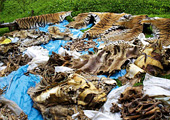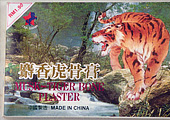|
It
is the hardest bit of evidence yet in favour of what conservationists
have long argued, but may not be enough to save wild tigers. Even
as an interim census released on May 23, 2007, revealed a sharp
decline in the population of tigers in Madhya Pradesh, Maharashtra
and Rajasthan, China is lobbying hard to get the international
ban on trade in tiger parts lifted.
Will the census indicators galvanise
India's opposition to China's proposal? There's reason for optimism.
"These numbers show that the tiger is under serious threat
from poaching as well as from loss of habitat over the last couple
of decades. The ban on tiger trade should not be lifted as it
will encourage poaching," says Rajesh Gopal, Member Secretary,
National Tiger Conservation Authority, and Head, Project Tiger.
The contentious issue is being
thrashed out at the triennial conference of the Convention on
International Trade in Endangered Species (cites) at The Hague
from June 3-15, 2007. cites is an international agreement that
controls the trade in wildlife.
It is shaping up as a China
versus the rest battle. China is pressing for a lifting of the
ban on trading in tiger parts and the rest of the world is sitting
up and opposing this. And understandably, wildlife conservationists
are crying foul over attempts at turning tigers into poultry chicken.
|

|
| Tiger bone wine is openly available
for sale in China (bottom); a brochure advertising tiger bone
wine |
 |
"Lifting the ban will drive
up demand, create new markets and also provide room for traders
to mix up illegally killed wild tigers with 'legitimate' farmed
tigers. It's a bad idea all around," points out Ullas Karanth,
renowned tiger biologist and Director, Wildlife Conservation Society,
India.
China has often been criticised
for lax implementation of the 14-year-old ban. As proof, experts
point to the rampant proliferation of tiger and leopard products
in China and Tibet. Many tiger wine factories openly operate in
China and thousands of bottles of wine, often priced as high as
$135 (Rs 5,535) each, are sold annually. Sue Lieberman, Director,
WWF Global Species Programme, World Wildlife Fund, says tigers
are being bred like "chicken on a farm".
Despite the ban, the scenario
remains bleak in India. Poachers have cleaned out the tiger population
at the Sariska Tiger Reserve in Alwar, Rajasthan. According to
the interim census, there are only 265 tigers in Madhya Pradesh
and 95 in Maharashtra compared to 710 and 238, respectively, in
2002.
This is despite an action plan
already in place for tiger reserves. "The states with tiger
reserves need to urgently focus on better protection and management
of their reserves as laid down by the National Tiger Conservation
Authority. A six-point action plan has already been sent last
December but the states are yet to get their act together,"
laments an MOEF (Ministry of Environment and Forest) official.
|
CHINASPEAK
China is offering
a three-pronged argument to buttress its case.
|
|
»
Banning trade
hasn't worked to save India's wild tiger population
»
India's conservation methods haven't been successful
»
Farming/harvesting
is the only way out for the survival of the species
|
China is leaving no stone unturned
to have the ban lifted; this will facilitate its traditional medicine
industry. A Chinese delegation of State Forestry Administration
(SFA) officials visited India thrice in last one year to discuss
the modalities of lifting the ban on trade in tiger products.
According to Ministry of Environment
and Forests officials, Chinese officials questioned India's conservation
methods at the meeting and emphasised that since banning the tiger
trade hasn't worked, farming and harvesting the big cat could
offer for an alternative model for ensuring the survival of the
species.
India is not yet buying China's
arguments over the issue. "We feel that the ban on trade
in body parts of wild animals is an effective way of saving the
species," says an official spokesperson for MOEF.
|
THE TIGER TRADE TRAIL
Here's a look at the facts and fallacies.
|
|
ASSUMPTION
|
FACT |
| Legalising domestic tiger trade
is the sovereign right of any nation. |
CITES* resolution asks member countries
to prohibit trade in tiger parts and derivatives even from
captive-bred specimen. |
| The ban on tiger trade has not
worked; so it is time to try a new approach. |
The ban on trade in tiger products
has helped Russia's tiger population to recover and other
wild tiger populations, including India's, to persist. |
| Tiger farming will meet the demand
for tiger products at affordable prices. |
Raising a farmed tiger to maturity
is 250 times as expensive as poaching a wild tiger in India. |
| Legal trade in farmed tiger products
will decrease demand for parts of wild tigers. |
Legalising the trade will create
demand from existing consumers and new consumers, thus, becoming
a vicious cycle. |
Source: CATT: Campaign
Against Tiger Trafficking & International Tiger Coalition
*CITES (the Convention on International Trade in Endangered
Species of Wild Fauna and Flora) |
The Chinese government is building
a case for lifting the ban under immense pressure from its tiger
farming lobby, and India's endorsement is vital as the country
is home to more than 50 per cent of the world's wild tigers.
|

|
 |
| Tiger bone plaster, a traditional
Chinese medicine, is gaining popularity in Malaysia |
The stakes are equally high for
India. "From the looks of it, if China reopens tiger trade,
inserting the parts of poached tigers from India into the market
will be dead easy," says Judy Mills, Director, Campaign Against
Tiger Trafficking (CATT) Save The Tiger Fund and member of the
International Tiger Coalition.
China has raised the issue time
and again. During the fourth General Assembly of the Global Tiger
Forum held in Kathmandu last month, Chinese officials wrote to
cites, stating that the ban on trade in tiger parts had cost their
economy $4 billion (Rs 16,400 crore). Captive-bred tigers in Chinese
farms, they claimed, could sustain the trade and also replenish
the wild stock.
|
WARNING SIGNS
Incidents of illegal
tiger trade reported in the Chinese media.
|
|
1997: CCTV reporter
Junyi Shui exposed the fact that Shenzhen Wildlife Park
was illegally selling tiger bone wine from its cellar to
tourists and restaurants outside the park.
December 2002: China imported
100 tigers from Thailand to stock a new wildlife park in
Sanya, Hainan province, so that consumers could "taste
tiger meat".
2003: Yunnan Liang He Medicine
Co. made tiger bone wine from confiscated 'Bengal' tiger
bone with permission from government authorities-with a
medicine retail permit for good measure.
October 2005: China's Forestry
Administration denies western media reports about a possible
lifting of the tiger trade ban in China.
February 2006: Shanghai Wildlife
Park, in collaboration with a liquor factory, was found
to be producing and selling a health-tonic wine. It was
made from bones of tigers killed by buses carrying tourists
through the park.
August 2006: A report in the
China Youth Daily exposed the fact that Xiong Sen Bear and
Tiger Farm in Guangxi Province was openly and illegally
making tiger bone wine in its cellar. The cellar had over
400 vats of wine, each of which also contained a tiger carcass.
September 2006: Magazine Beijing
Technology mentions that the farm's restaurant lists tiger
meat on its menu under the name "Meat of the King".
Source: International Fund for Animal Welfare
|
However, conservationists all
over the world challenge such claims. The primary argument: "Commerce
and conservation can never be bedfellows," says renowned
conservationist Mike H. Pandey.
Captive-bred tigers, experts
point out, cannot survive in the wild as they cannot hunt or find
mates and often turn man-eaters. Also, tigers are poised at the
top of the food chain and, therefore, measure the health of entire
ecosystems. Saving tigers will save entire landscapes of life
as well as human livelihoods.
Besides, farming can work with
species that are low-maintenance and prolific breeders, like crocodile.
"It will always be much more lucrative to poach a wild tiger
for less than $50 (Rs 2,050) than spend $5,000 (Rs 2,05,000) to
rear one. A legal market will spell doom for the few remaining
tigers in the wild," says P.K. Sen, noted tiger conservationist
and former Head of Project Tiger.
China is under pressure from
many countries to maintain the ban. On May 3, 2007, the US government
administration assured the Congress that it would actively work
to keep China's 14-year-old ban in place at the cites meeting.
Conservationists consider this
support crucial. "It is critical that the US and other important
partners of China speak up for tigers at the cites conference,"
says Mills.
As representatives from 169
member countries converge at The Hague, the big question is: will
conservation succumb to commerce? "It's a make or break situation,"
says Belinda Wright, Director, Wildlife Protection Society of
India. "If we lose this fight, we've lost the battle."
The fate of the tiger hangs in balance.
|









